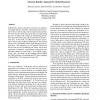Free Online Productivity Tools
i2Speak
i2Symbol
i2OCR
iTex2Img
iWeb2Print
iWeb2Shot
i2Type
iPdf2Split
iPdf2Merge
i2Bopomofo
i2Arabic
i2Style
i2Image
i2PDF
iLatex2Rtf
Sci2ools
ICCAD
1999
IEEE
1999
IEEE
Attractor-repeller approach for global placement
Traditionally, analytic placement used linear or quadratic wirelength objective functions. Minimizing either formulation attracts cells sharing common signals (nets) together. The result is a placement with a great deal of overlap among the cells. To reduce cell overlap, the methodology iterates between global optimization and repartitioning of the placement area. In this work, we added new attractive and repulsive forces to the traditional formulation so that overlap among cells is diminished without repartitioning the placement area. The superiority of our approach stems from the fact that our new formulations are convex and no hard constraints are required. A preliminary version of the new placement method is tested using a set of MCNC benchmarks 1 and , on average, the new method achieved and reduction in wirelength and CPU time compared to TimberWolf v7.0 in hierarchical mode [10].
| Added | 03 Aug 2010 |
| Updated | 03 Aug 2010 |
| Type | Conference |
| Year | 1999 |
| Where | ICCAD |
| Authors | Hussein Etawil, Shawki Areibi, Anthony Vannelli |
Comments (0)

